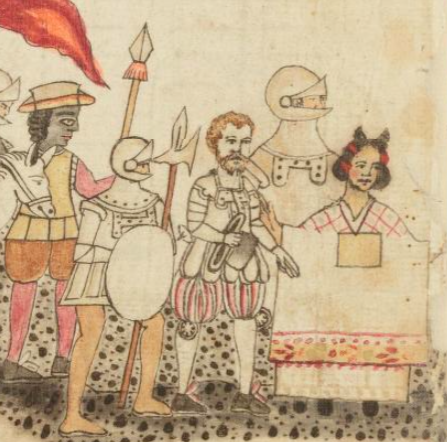español (Azca29)
This painted black-line drawing of the iconographic example of a Spaniard features Hernando Cortés. The contextualizing image shows he is part of the invading party of 1519. He stands next to his interpreter, doña Marina (also known as Malintzin, with the Nahua honorific, and Malinche, the Hispanized form). Here, Cortés is standing in a frontal view, holding his dark gray or black hat in his right hand. His curly reddish hair is uncovered. He sports a mustache and a short beard. His breeches or pantaloons are puffy, with red and white vertical stripes. He wears white socks on his legs below the knee, and he has black shoes with red ties. His upper body garment appears to be a type of armor, but unlike his comrades, he is not carrying a weapon.
Stephanie Wood
The other examples of Spaniards in this collection so far (June 2025), including those of a number of nahuatlatos (interpreters), are all iconographic examples, not glyphs. We are on the lookout for glyphs of Spaniards.
Stephanie Wood
post-1550, possibly from the early seventeenth century.
Jeff Haskett-Wood
etnicidades, invasores, entradas, expediciones
español, a Spaniard (male), https://nahuatl.wired-humanities.org/content/espanol
The Codex Azcatitlan is also known as the Histoire mexicaine, [Manuscrit] Mexicain 59–64. It is housed in the Bibliothèque Nationale de France, and hosted on line by the World Digital Library and the Library of Congress, which is “unaware of any copyright or other restrictions in the World Digital Library Collection.”
https://www.loc.gov/resource/gdcwdl.wdl_15280/?sp=29&st=image
The Library of Congress is “unaware of any copyright or other restrictions in the World Digital Library Collection.” But please cite Bibliothèque Nationale de France and this Visual Lexicon of Aztec Hieroglyphs.

